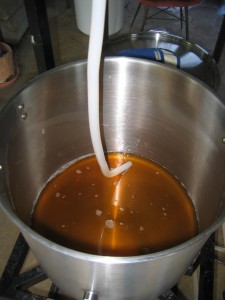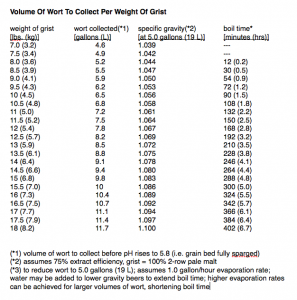How much wort should you have in your kettle or brewpot before the boil? The answer depends on whether you are an all-grain or extract brewer. In addition, among all-grain brewers, the amount of wort you should collect depends on which you value more, extract efficiency or the time and energy to boil away more wort. In this series of articles, I’ll discuss each option with regards to extract efficiency, brewer effort required and beer quality.
Fly Sparging
One way continuous spargers collect their wort is to drain the first wort, begin adding sparge water before the top of the grain bed is exposed and collect wort up to the point that the pH of the final runnings rises to 5.8. This should happen when the specific gravity drops below 2–3 °Plato.
The other way they do it is to collect the amount of wort that can be boiled down to their target post-boil volume in 60 to 90 minutes. For 5.0 gallon (19 L) batches, this is usually 6.0 to 7.25 gallons (23–27 L), depending on your kettle evaporation rate.
Using the first method, the volume of wort collected is tied to the weight of the grist. For low-gravity beers, with a light grist, the brewer may need to add water to reach a reasonable pre-boil volume. Reasonable meaning a volume of wort that can be boiled for 60 to 90 minutes and yield the expected post-boil volume. For high-gravity beers, with larger grists, the wort may need to be boiled for longer than 90 minutes to reach the desired post-boil volume. The advantage of doing it this way is that your extract efficiency is high (if you do it right), and constant with respect to the size of your grain bill. In addition, wort collection ceases before excess tannins can be extracted from the grain husks in the grist. The disadvantage is that you need to monitor the pH of your final runnings (or estimate how much wort you can collect based on previous beers).
The benefit of using the second method — collecting a fixed pre-boil volume — is simplicity. For every beer, no matter the size of the grain bill, you collect the same amount of wort and boil for the same amount of time. This makes it easy to plan your brewday.
However, the downside is that the brewer’s extract efficiency decreases with increasing grist weight. For progressively larger grists, more and more sugars are left behind in the grain bed when the brewer stops sparging at his target pre-boil volume. Conversely, for lighter grists, the brewer is likely oversparging — causing the grain bed pH to rise above 5.8 and excess tannins to be extracted.
Conclusion
So, if you want to fully-sparge your grain bed, but not extract excess tannins, you should monitor the pH of your final runnings and quit collecting when the pH reaches 5.8. On my system, this occurs on average when I’ve collected 0.65 gallons of wort per pound of grain (5.5 L/kg). So, if I mash 10 pounds (4.5 kg) of grain, I can collect 6.5 gallons (25 L) of wort. Your ratio of grain weight to wort volume will vary due to differences in water chemistry and other variables, but probably not by much. Once you find it out, you can estimate how much wort to collect — which will let you know when to start taking the pH of your final runnings and how much time to plan for your boil.
I don’t take the pH of my final runnings every time I brew anymore. I use the grain weight to wort volume ratio as a guide, and may additionally cut my wort collection short on big beers to limit my boil time or when the size of my kettle becomes limiting.
If you want to keep your pre-boil volume constant, and hence your brewday procedures the same each time, be aware of losing extract efficiency on high-gravity beers and extracting excess tannins on lower gravity beers. The earlier can be compensated for by mashing more grain or adding malt extract in the boil. The latter can be compensated for by stopping wort collection before you reach your pre-boil volume and adding water to make up the deficit.
On Monday, I’ll discuss wort collection with other lautering methods for all-grain brewers and wort volumes for extract brewers.



I love your Blog! I think you guys can read my mind. I was brewing a porter last week, before I read your post and while that was in the carboy I brewed a SMaSH with 17 lb of 2 row and Sorachi Ace and was trying to figure out how to calculate my volume. It appears that I have been going about it all wrong. Thanks for the advise! Keep up the good work, I really enjoy this blog!
Hi.
Volumes in second column: Are they shown in gallons or liters?
Gallons